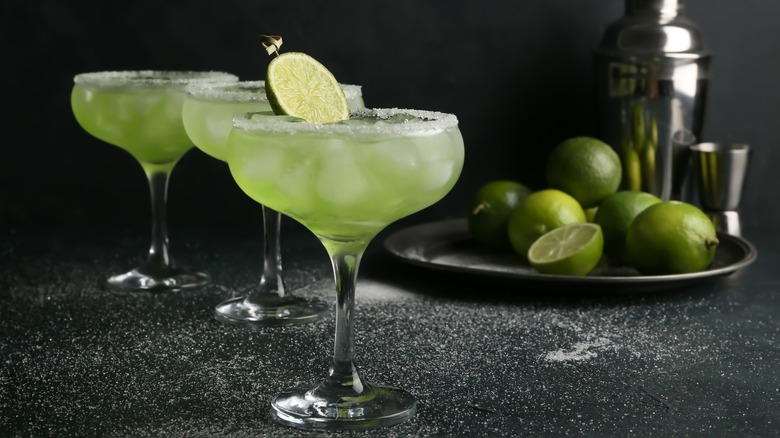The Golden Ratio Bartenders Use To Build Cocktails From Scratch
All great artists have a keen sense of proportion. In the world of painting, for example, ideal proportions are expressed by means of the so-called golden ratio, a mathematical formula long used as a measure of aesthetic perfection.
Bartending, another fine art, has its own version of the golden ratio; a formula that has evolved over time to ensure that all cocktails are crafted using an ideal balance of flavors. This formula is expressed as 2:1:1, with the first number representing the base liquor (or liquors), and the second and third numbers referring to sweet and sour flavors, respectively.
The embracing of the golden ratio in bartending has contributed immeasurably to the development of modern mixed drinks. Base liquors like rum or gin or bourbon, for instance, have often been used interchangeably with the same sweet and sour ingredients to create unique and iconic cocktails. The gimlet and the daiquiri, for example, both rely on simple syrup and lime juice for their sweet and sour components. The only difference is the base liquor. The former uses gin, the latter rum.
The history of the golden ratio
Although the practice of mixing drinks dates back many thousands of years, early mixology efforts mostly involved blending various fermented beverages. The idea of pairing a spirit with sugar and a citrus fruit to create a cocktail is a more recent invention, albeit one with a long history — perhaps as many as 1,500 years — in India.
The ancestral home of the modern cocktail, India is responsible for the invention of the punch, a mix of regional liquor with sweet, sour, and spice elements that provided the first known use of a recipe similar to what would eventually be known as the golden ratio. Britain introduced punch to Europe after colonizing India in the 17th century, and added a newly-popular spirit known as rum to help create the nascent cocktail culture that would soon take root in another far-flung colony: America.
The earliest evidence for cocktail making in America dates to 1806; not coincidentally, a few years after the introduction of ice. Cocktails such as the Sazerac and Mint Julep were developed in the U.S. during the first half of the 19th century, and had already achieved classic status when Professor Jerry Thomas created the first true cocktail guide in 1862: "How to Mix Drinks or The Bon-Vivant's Companion." While there is no definitive date for the widespread observance of the golden ratio, its principles were recognized in the 19th century, and were certainly in use by the Prohibition era.
Classic cocktails that use the golden ratio
Nearly all contemporary cocktails adhere to the 2:1:1 formula. Of course, there's no such thing as a rule that can't be broken, so enterprising bartenders throughout history have toyed with golden ratio's parameters, often with spectacular results. The Manhattan, a drink that omits sour flavors entirely, is an acknowledged classic. So, too, is the martini, another cocktail that rebuffs the golden ratio.
But the one thing most great cocktails have in common is proper proportion, as measured by the golden ratio. The gimlet and daiquiri both follow this formula. So, too, does the most frequently ordered cocktail in the U.S., the margarita. This popular mixed drink typically features two ounces tequila, paired with half that measure of triple sec and lime juice.
The golden ratio enables the seamless blending of diverse ingredients to create balanced flavors, and its core principles have not only resulted in a host of iconic cocktails, but myriad variations. The whiskey sour, for example, follows the traditional golden ratio formula, pairing its namesake base liquor with simple syrup and lemon juice, plus bitters, garnish, and an egg white for texture. This recipe was tweaked only slightly to create another popular cocktail, the bourbon-based Gold Rush, which uses honey syrup rather than sugar for its sweetness component, and eschews the inessential egg white and bitters. Change gin to bourbon, and the Gold Rush magically transforms into a Bee's Knees. Such is the genius of the golden ratio.



